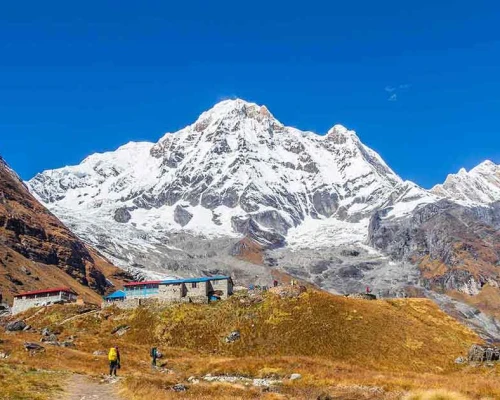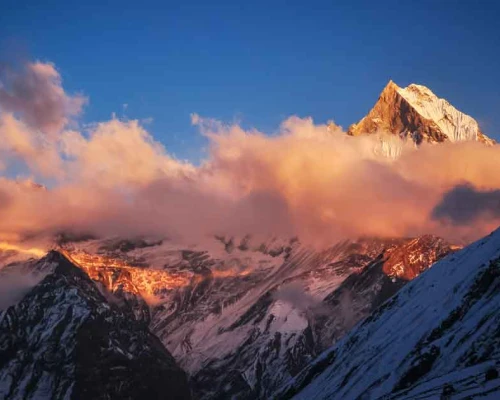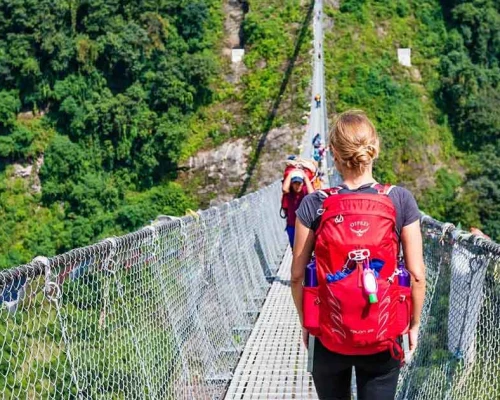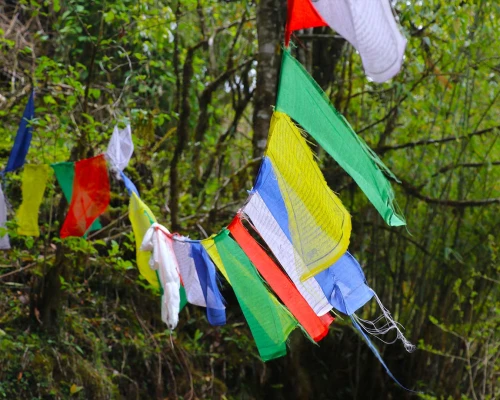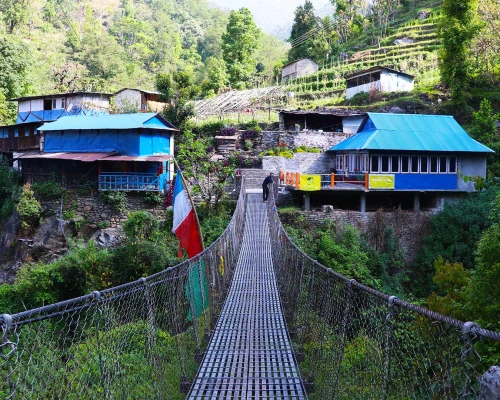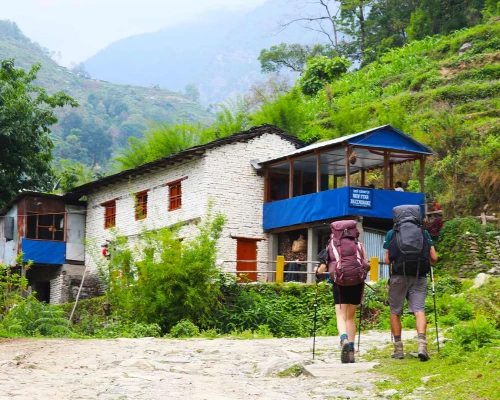Annapurna Base Camp Trek stands as the second most renowned trekking experience in Nepal, attracting trekkers from across the globe. It offers an exciting and somewhat challenging opportunity to get close to an amazing eight-thousander. The chance to witness such a magnificent peak adds a new level of excitement to the trek, turning it into an absolutely amazing adventure.
The ABC Trek Package is a 10-day trek to the base camp of Mount Annapurna, providing stunning views and adventure through diverse terrain and cultural experiences. Pass through beautiful Gurung villages, terraced farmland, and an amazing variety of flora and fauna on your journey to Annapurna Base Camp.
Situated at 4,130 meters (13,549 feet) above sea level, the Annapurna Base Camp is one of the most well-liked trekking destinations worldwide. Mesmerizing trekkers along the way is the spectacular Mt. Machhapuchhre (Fishtail), which rises to a height of 8,091 meters and is the tenth-highest mountain in the world.
The trek to Annapurna Base Camp is an extraordinary journey that combines breathtaking landscapes, cultural immersion, and personal growth. It is a trek that challenges and rewards you, leaving you with memories that will last a lifetime. Whether you're an experienced trekker or a novice adventurer, this trek offers a unique opportunity to witness the grandeur of the Himalayas and experience the warmth of Nepalese hospitality.

The Annapurna Base Camp trek begins with a 7- to 8-hour drive from Kathmandu to Pokhara, a city famous for its lakes and views of Dhaulagiri and Manaslu peaks. The next day, we drive to Nayapul and start trekking to Tikhedhunga. Along the way, you'll visit charming villages like Ghorepani, Chommrong, Sinuwa, and Deurali. The main attraction is the Annapurna Base Camp, surrounded by towering Himalayas. After exploring the Hidden Valley, the trek continues to Bamboo, Jhinu Dada, and Birethanti before returning to Pokhara.
The ten-day trek to Annapurna Base Camp passes through the heart of Nepal's magnificent Annapurna mountain range. There are several remarkable highlights along the way. At 4,130 meters above sea level, arriving at Annapurna Base Camp itself is one of the most breathtaking experiences. Standing amongst towering peaks, like the tenth-highest mountain in the world, Annapurna I, you can't help but experience a sense of achievement and amazement.
So why wait? At NTA, we go above and beyond to support you in achieving all your trekking goals. We are excited to travel with you, creating treasured experiences throughout the trek. Bookings are open for the years 2026, and 2027, so please contact us and make your reservations now.
Major Attractions of Trekking to ABC
Here are some of the major attractions of doing this trek. We ensure that we provide you with the best experience without compromising your safety.
- The stunning variety of the Himalayan landscape
- Remote settlements and fairy-tale forests
- Expansive woodland divided by cascading rivers
- Glittering blue-hued peaks of base camp at dusk
- Breathtaking sunrise over the Annapurna mountains from Poon Hill
- Knowledgeable trek leaders, assistant guides, and porters
- Immersion in the rich Sherpa culture
- Rest and relaxation in Pokhara
- A boat ride along Phewa Tal (Lake) with views of snow-capped mountains
- View the enormous Annapurna Conservation Area
Annapurna Base Camp Itinerary
Starting from Kathmandu, the Annapurna base camp trek route begins with a scenic drive to Pokhara, passing through hills and dense forests. Upon reaching Nayapul, the actual adventure commences as the trek begins. Along the way, trekkers make memorable stops at various places, including Ghorepani Poon Hill for a sunrise view, Tadapani, Deurali, the ultimate destination of Annapurna base camp, Jhinu Dada, and more.

Alternatively, one can opt to fly from Kathmandu to Pokhara to kickstart the trek to Annapurna base camp. After arriving in Pokhara, a drive to Nayapul and a trek to Tikhedhunga follow, shortening the trek's overall duration. At the end of the trek, instead of returning directly to Kathmandu from Pokhara, travelers have the option to extend their stay in Pokhara.
In this case, we can provide a return bus ticket from Pokhara to Kathmandu, marking the end of our collaboration. If you're interested in booking a Pokhara sightseeing tour with us, we can accommodate that as well, although it would include additional costs.
Benefits of booking ABC trek with us
Here are some of the reasons why you should book your trek to Annapurna Base Camp with Nepal Trek Adventure.
- Simple reservation and booking process
- We offer free cancellation service if informed 90 days prior the trek
- Upon booking confirmation, a brief travel briefing will be held after your arrival
- Simple payment method
- 24/7 communication by contacting: +977 9851017030 (Binod Sapkota)
- Highly expert and experienced team
- Customization provided for your 10-day trek to Annapurna Base Camp according to your request
- Commitment to responsible and sustainable tourism
Annapurna Base Camp Trek Cost
The cost of the Annapurna Base Camp trek is $795 per person on a group sharing basis for the years 2026, and 2027. This complete package covers meals and accommodations during the trek, permits, transportation services, and guides and porter services.
We offer the flexibility of both ABC group joining and private treks, allowing you to choose the option that suits you best. If you prefer to join a group, you'll have the opportunity to meet like-minded adventurers from around the world, creating an enriching and social experience.
On the other hand, if you prefer a more personalized journey, the private Annapurna Base Camp trek cost ranges from $650 to $995 Perperson. The private treks ensure that your individual needs and preferences are catered to, providing a sense of exclusivity and freedom.
We understand that cost plays an important role in decision-making, and that's why we provide the best-guaranteed ABC Trekking Cost. Please note that the cost of the Annapurna base camp trek also depends on the itinerary, group number, duration, and so on.
By tailoring the trek to your specific requirements, we ensure that you get the best value for your investment. So whether you're traveling solo, with a group of friends, or even as a family, we are here to make your trek to ABC an incredible and unforgettable adventure.
Annapurna Base Camp Trek Route
The Annapurna base camp trek starts with a picturesque drive from Kathmandu to Pokhara, a city renowned for its lakes. The journey, spanning approximately 7 to 8 hours, offers breathtaking views of majestic Himalayan peaks such as Dhaulagiri (8,167m) to the west and Manaslu (8,156m) to the east.
The next day, the adventure continues with a drive from Pokhara to Nayapul, marking the starting point of the trek towards Tikhedhunga. While going on this trek, we begin our tour in Kathmandu and proceed to Pokhara, enjoying the scenic beauty en route.
As the trek unfolds, you'll have the opportunity to experience and stay in several enchanting villages, including Ghorepani, Chommrong, Sinuwa, and Deurali. The allure of these villages lies not only in their natural beauty but also in the unique cultural experiences they offer along the way. Each stop along the route adds to the overall tapestry of this incredible trek.
You will see the Annapurna massif from two different perspectives while trekking: a 360-degree view of the same massif from Base Camp, and a panoramic view from Ghorepani. The ultimate highlight of the trek is, undoubtedly, the Annapurna Base Camp itself. Situated amidst towering Himalayan peaks, the base camp provides an awe-inspiring panorama that will leave you utterly mesmerized. The surrounding views at this elevated destination offer an uninterrupted spectacle of the majestic mountains that encircle the base camp, creating an unforgettable experience.
The trail then takes you further, either towards the Himalaya or Sinuwa, depending on the chosen route. Finally, the much-anticipated next stop is the Annapurna Base Camp, where the towering peaks create a majestic backdrop. After exploring the Hidden Valley, the trek leads to Bamboo, Jhinu Dada, and eventually Birethanti.
After a night in Jhinu Dada, the concluding phase of the trek involves a return drive to Pokhara. This allows for a reflective conclusion to the expedition, providing an opportunity to appreciate the diverse landscapes, cultural encounters, and, most significantly, the majestic Himalayan vistas that characterize the Annapurna Base Camp trek.
Best Time to do ABC Trek
The spring season, from March through May, is the ideal time of year to trek to Annapurna Base Camp. Trekking is best during this time of year because of the clear skies and cool temperatures. The blossoming rhododendron woods brightly color the scenery, and the weather is often steady. Also, this is the best time to see the amazing views of the nearby peaks, such as Machapuchare and Annapurna I.
Another best time is during the autumn season, from September to November. The weather remains pleasant with clear skies, allowing for excellent visibility of the majestic mountains. The autumn season offers cool temperatures and relatively dry conditions, making it easier to trek through the diverse terrain. The trails are usually less crowded compared to the spring season, providing a peaceful and serene trekking experience.
The spring season (March to May) and autumn season (September to November) are generally considered the best seasons for ABC trekking due to the pleasant weather, clear skies, and optimal trekking conditions.
Here is a complete overview of all the seasons and their temperature ranges.
Season | Months | Daytime Temperature (°C) | Nighttime Temperature (°C) | Considerations | ||||||||
Spring (Pre-Monsoon) | March, April, May | 15-25°C | 5-10°C | - Clear skies, blooming rhododendrons, comfortable temperatures. - Peak season with larger crowds. - Possible pre-monsoon showers in May. | ||||||||
Summer (Monsoon) | June, July, August | 18-28°C | 10-15°C | - Lush green landscapes, fewer crowds. - Higher risk of rain and landslides. - Trekking paths can be muddy and slippery. | ||||||||
Autumn (Post-Monsoon) | September, October, November | 12-22°C | 0-5°C | - Stunning mountain views, stable weather, pleasant temperatures. - Another peak season with larger crowds. - Potential for cold nights at higher altitudes. | ||||||||
Winter | December, January, February | 5-15°C | -10°C to -5°C | - Dramatic snow-capped peaks, fewer crowds. - Coldest temperatures, increased risk of snow and ice. - Some teahouses and trails may be closed. | ||||||||
Book now and get free t-shirts, caps, and stickers.



